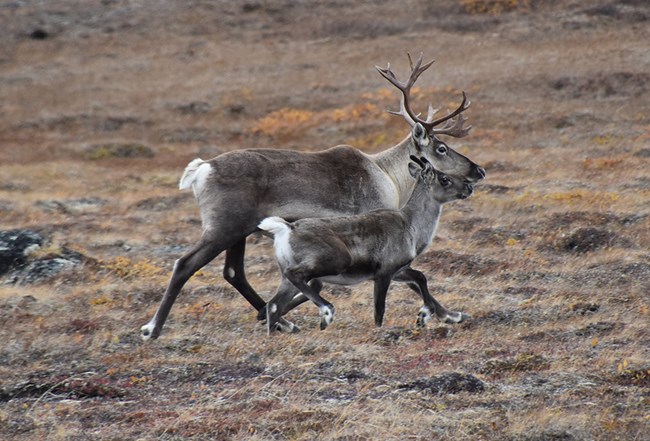Last updated: May 22, 2025
Article
What determines caribou migration strategies?

NPS/Kyle Joly
Caribou are known for their long-distance migrations. What is less well known is what influences their movements. In a study of the Nelchina Caribou Herd, it was determined that their movements were affected by:
- migratory strategy - whether individuals migrated to distant winter ranges or remained close to their summer range;
- group size - the number of other individuals present nearby; and
- environmental conditions - snow depth and temperature.
Migratory caribou moved more than non-migratory caribou throughout the year, even during the non-migratory summer and winter months. Researchers speculate this is related to a life history strategy to maximize their year-round energy intake. It may also be related to competition and larger groups depleting forage resources quicker as caribou in larger groups had higher movements rates. Shallower snow and warmer temperatures were also related to increased movements.
Understanding what drives the movements of caribou can help biologists conserve caribou in Alaska.
Influence of Migratory Strategy, Group Size, and Environmental Conditions on the Movements of Caribou in Eastern Alaska
Abstract
Migration is a diverse behavior exhibited by a wide array of organisms. Variability in the type of movements is rooted in their purpose, environmental factors, demographics, and individual physiological condition. The ability of caribou (Rangifer tarandus granti) to efficiently move long distances and have a high degree of plasticity in their movements allows them to respond and be resilient to dynamic and dramatic differences in environmental conditions. I used 88 collared, sympatric, adult, female, barren-ground Nelchina Caribou Herd caribou in east-central Alaska to assess their migratory strategy (as indexed by the distance between winter and summer ranges) and how this might affect their movements. Employing 41,682 movement vectors from 39 of these individuals equipped with GPS collars, I compared the annual and monthly movements of caribou that were found on different winter ranges. Distances between winter and summer ranges for individual caribou were correlated with their annual movement, but not for caribou that wintered within the same area. As expected, caribou with the greatest distance between their winter and summer ranges (300 km) traveled the most annually (2,132 km/year), whereas caribou with the shortest distance between ranges (71 km) traveled the least annually (1,368 km/year). However, caribou that migrated the furthest exhibited greater movement rates in all non-migratory summer months and most non-migratory winter months, as well as during migration. Movement rates were the greatest in summer, peaking in July, regardless of where caribou wintered. During the winter months, movement rates were similar among caribou found on different winter ranges and decreased over the winter, reaching minimums in January-March. Caribou that migrated the shortest distance and had lower movement rates tended to be found in smaller groups in summer. The connection between group size and movement rates may be a function of competition or a small-scale example of the larger-scale phenomenon of range expansion of large herds. Environmental factors, such as snow depth and temperature, were also correlated (negatively and positively, respectively) with caribou movement rates. Survival was not significantly different for caribou utilizing different winter ranges, which implies that the benefits of this long-distance migration can be offset by its costs. A more detailed understanding of the drivers and variability of caribou movement should help improve the management of this declining species.
Joly, K. 2025. Influence of migratory strategy, group size, and environmental conditions on the movements of caribou in eastern Alaska. Animals 15(10): 1453.
